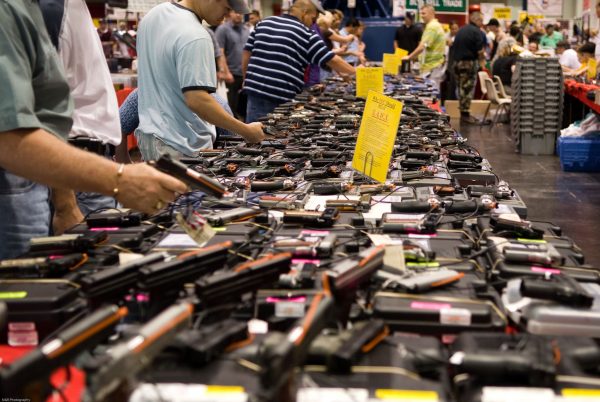Simon Williams, Flinders University
(This article is from March’2016 and highlights the severity of gun control in USA)
United States President Barack Obama continues to push for reform on gun control amid concerns that people will “become numb” to any further mass shootings, which he says are now happening on a weekly basis.
His comments followed a shooting in Kansas last month in which three people died and 14 were wounded.
But his attempts to do something have been frustrated by a Congress that reportedly has not approved any major gun-control legislation since the 1990s.
Instead, the president used executive orders in January to announce new rules on background checks on people wishing to buy guns.
The litany of tragic gun deaths and horrifying mass shootings demanded action.
In the aftermath of a mass shooting in Oregon last year, the president challenged the media to compare gun deaths to terrorism deaths in the US. More than one organisation obliged.
Obama wanted news organizations to put gun deaths and terror deaths side-by-side. We did. http://t.co/Nhox2fBijv pic.twitter.com/Jf26cjo3mI
— Philip Bump (@pbump) October 1, 2015
To put this tweet into perspective, more than twice as many people in the US have died at the point of a gun last year alone as have died in terrorist attacks in all of the preceding 44 years put together.
So following on from the president’s challenge, what else do the numbers say on the gun debate in the US?
Apples and oranges
All sides in the debate try to use data to back up their assertions, but not everyone uses it responsibly.
This tweet from the National Rifle Association (NRA) is one of the most egregious examples of the misuse of data in the whole debate.
It compares gun homicides (a deliberate action) with accidental poisonings to create a wholly misleading comparison.
A ratio can only be constructed between like entities, such as the win-loss ratio of your football team.
A comparison such as this from the NRA only generates a rate; in this case there are approximately three accidental poisoning deaths per deliberate gun death.
The conclusion we are invited to draw is that there are bigger problems that we should deal with before gun deaths, but the comparison is meaninglessness.
This is not just poor data skills, it is part of a pattern of cherry-picked comparisons designed to further a political campaign and muddy the public discourse.
The use of gun homicides here is deliberate as it excludes the largest single cause of firearm-related deaths: suicide. Twice as many people in the US die from a deliberately self-inflicted gunshot wound as are murdered. A fact that makes all gun statistics look much worse.
The NRA would like to exclude these suicides from the debate and, therefore, claim these deaths shouldn’t count against the firearm death toll because guns don’t increase suicide rates, and if access to guns were restricted potential suicides would simply find another way.
But both of these assertions are demonstrably false. Research shows that 75% of suicide attempts are made within an hour of making the decision and that using a gun means a much lower likelihood of survival. Restricting access to guns, therefore, could save lives.
What ranking?
Another problematic notion is to conflate gun murders with all murders. That leads to such gems as this from the popular conservative blogger and commentator Bill Whittle.
The takeaway message from this video is that, even though the US ranks number one in per capita gun ownership, it only ranks around 100 in per capita murders.
A fairer comparison would be to compare all the damage caused by firearms (injuries and deaths by whatever means) with gun ownership. Using data collated from the Small Arms Survey and GunPolicy.org the following picture emerges.

Author provided
Only 22 countries are compared here due to the patchy availability and coherence of the injury data, but the trend is very different from the one promulgated by the gun lobby. The red trend line shows that an increase in gun availability increases the rate of injury and death.
Another misdirection practised by the gun lobby is to link gun ownership and crime prevention, but research conducted in the 1990s showed having a gun in your house increased your risk of being murdered by a factor of three.
Like to know more? Well, you can’t. The bill funding the Centres for Disease Control (CDC) in the US was amended to remove the funding for research on gun violence. Not only that but the ban was also quietly renewed this year.
The US vs Australia
As the US presidential campaign heats up, it will be interesting to see if gun control becomes an election issue. If it does, it will be interesting to keep an eye on the numbers used by various sides in any debate.
Australia’s gun laws entered the debate through Hillary Clinton’s comments that a similar buyback scheme is worth considering.
The reaction from the NRA and other conservative organisations was swift and negative.
Criticism of the effectiveness of Australia’s buyback scheme has centred on the fact that gun deaths were already decreasing and the rate did not change after the new laws and buyback were instituted. A close look at the data for the years around the buyback shows a different story:

Author provided
When plotted on a log scale, the trend lines for deaths pre- and post-1997 are identical, showing that the rate was indeed unchanged, but it is clear that the level dropped sharply by around 100 deaths per year following the buyback.
Based on CDC statistics, the gun death rate in the US is 10.4 per 100,000 people. The figure for Australia, based on Australian Bureau of Statistics data, is 0.93 deaths per 100,000 people.
Pause to let that sink in.
You are ten times more likely to die from a gunshot in America than you are in Australia.
I know where I feel safer.
![]()
Simon Williams, Lecturer in Mathematics, Flinders University
This article was originally published on The Conversation. Read the original article.

































